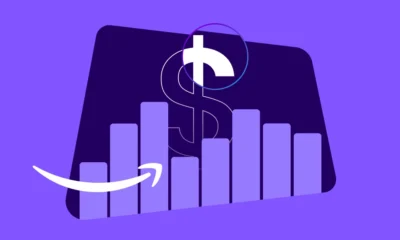SEO
7 Inspiring Content Marketing Examples (And Why They Worked)
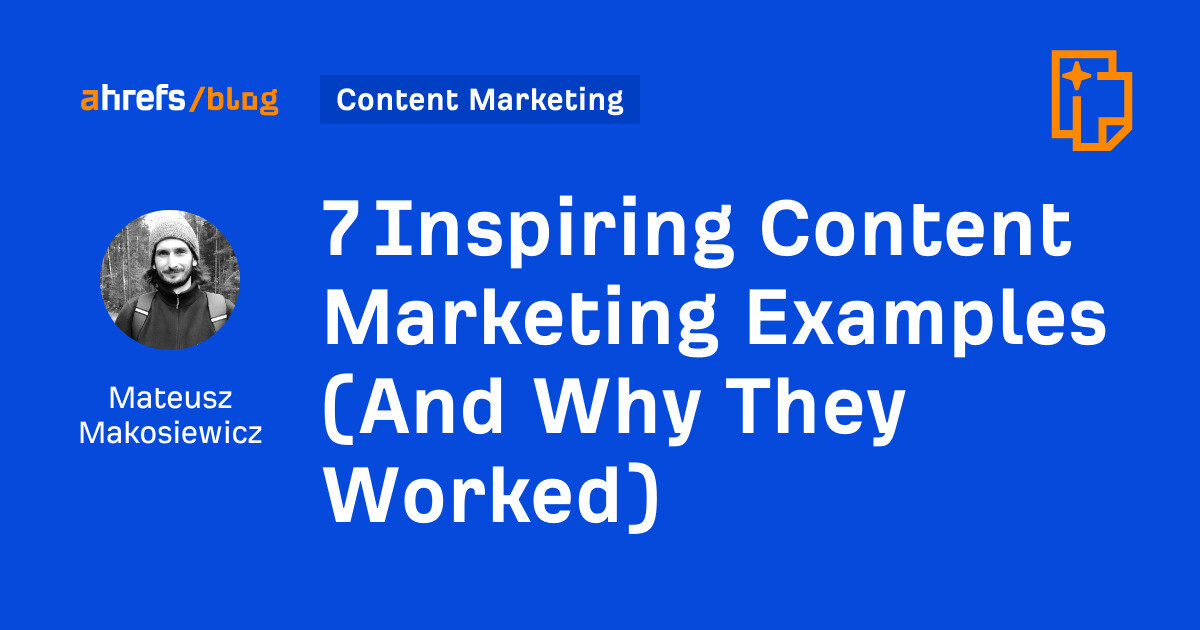
Everyone says content marketing is great, but what are some really good examples that actually delivered?
To answer this question, we’ve put our Content Explorer to work. These seven examples came from filtering over 6.2B live pages in English by organic traffic and referring domains.
We will also share our short analysis of why these examples came out so well.

Estimated monthly organic traffic: 5.1M
Backlinks: 3.7K from 1.8K domains
Adobe. In case you’ve heard about its product but haven’t heard about the company, it’s responsible for putting the “photoshopped” in “this photo looks totally photoshopped.”
Its claim to fame on this list is a tool that automatically removes the background from any pic for free so you don’t have to. If you’ve ever tried to do this manually, you’ll know why such a tool is a lifesaver.
Why it worked
Millions of people search for a solution like this every month, and Adobe ranks in the top three every time.
To illustrate, here are some of their top-performing keywords and their search volume in the U.S. alone.
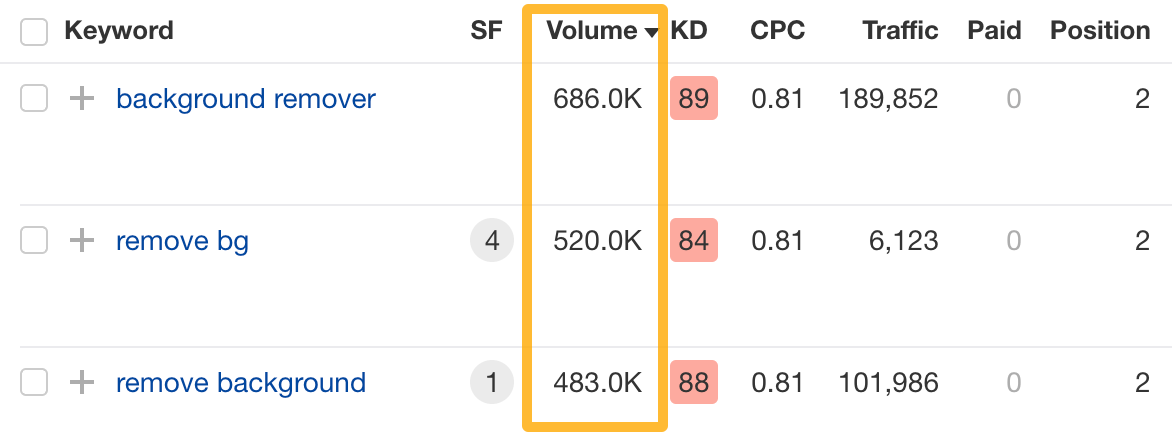
This site gets most of the traffic from India, where demand is even higher.
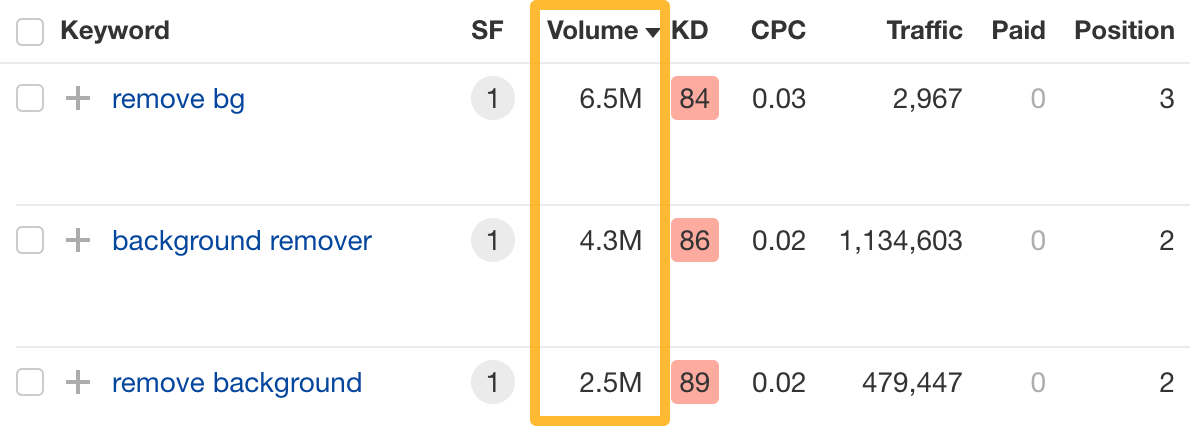
Naturally, it’s thought about a conversion path. Removing the background is free. But in case you need to resize the image too… Adobe always has a plan (pun intended).
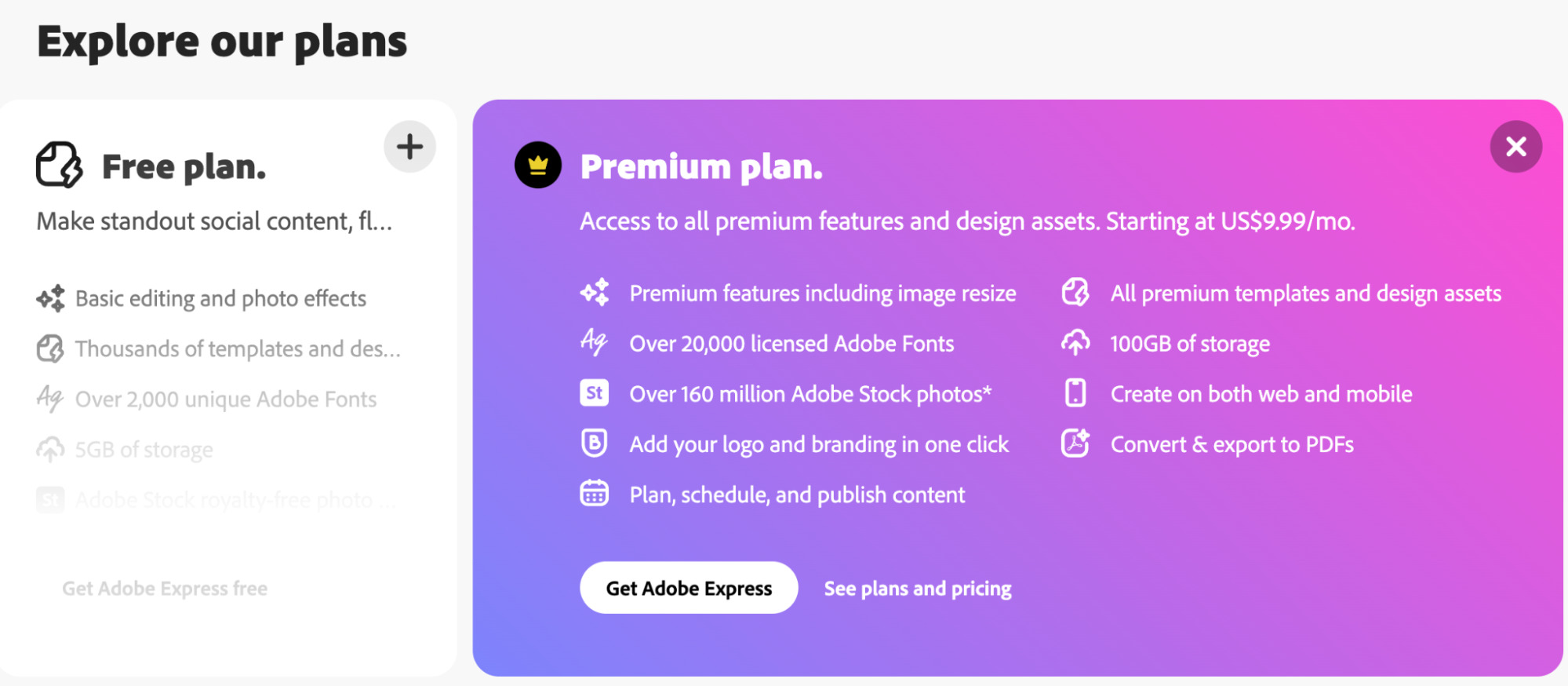

Estimated monthly organic traffic: 2.8M
Backlinks: 20.9K from 10.3K domains
This content marketing example is so effective that someone built an entire business on it.
It’s a free personality test. The site sells premium content on personal growth, customized based on the test outcomes.
Why it worked
In short, many people want to learn more about themselves and the people in their surroundings, so they seek advice in personality tests like this one. This company created an experience that stands out in every aspect, which allowed it to take advantage of that demand.
This single page ranks for over 7K keywords, many of which have tens and even hundreds of thousands in search volume. This explains such surprisingly high traffic for “just” a personality test.
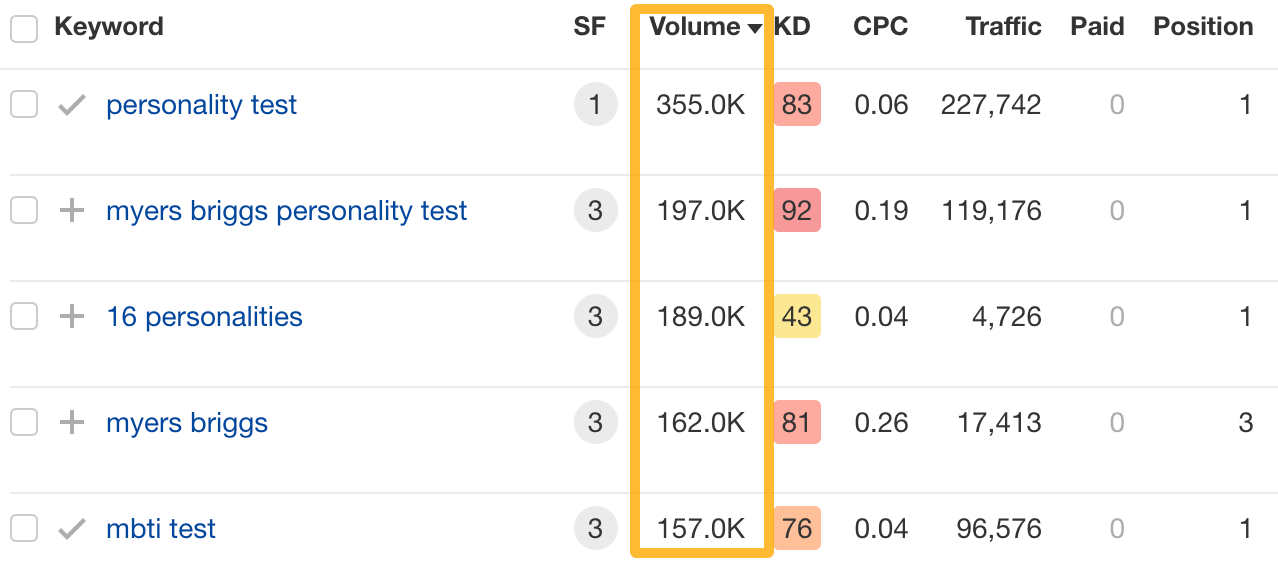
Another notable thing is how well the conversion path is designed throughout the site with the sole purpose of sending visitors to that page.
When you enter the site, there is absolutely no distraction; there’s 100% focus on the test.

After the test, you get a generous amount of free information on your personality. At that point, you’re most likely “hooked.” You’re then offered the opportunity to upgrade your experience: more advice, tips, and more specialized tests. And the site is selling this as frictionless as technically possible.
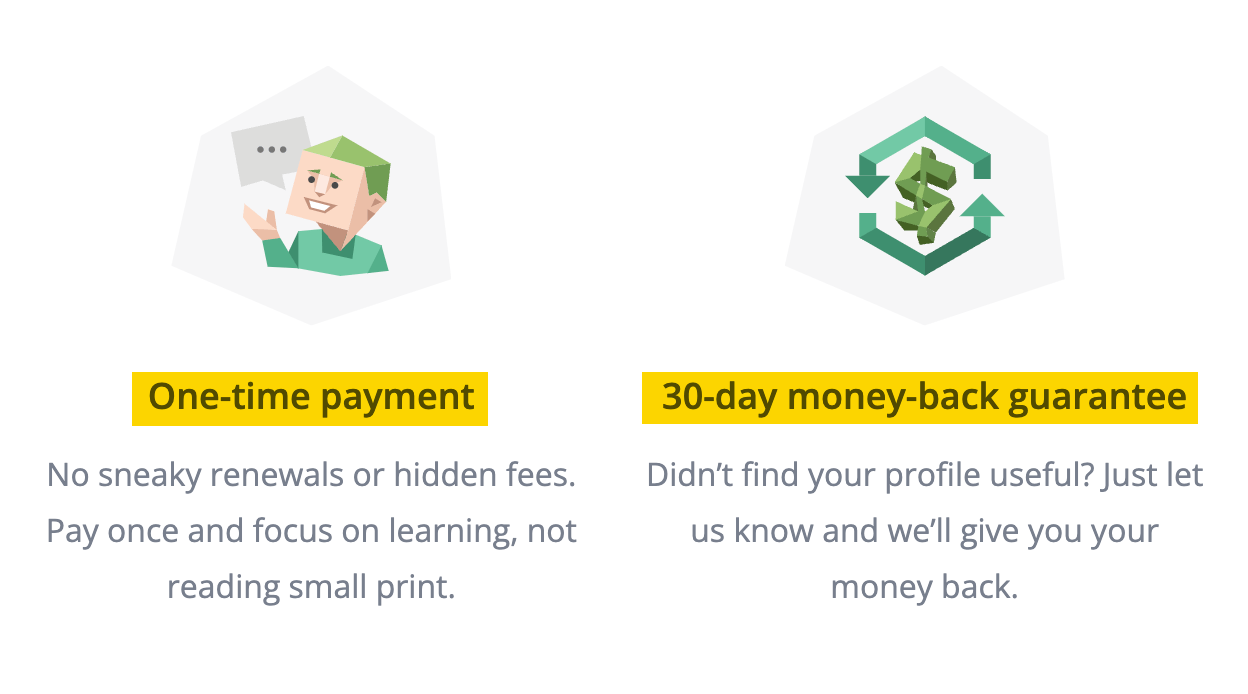
You even get an automatically created free profile which, I must admit, feels like your very own dedicated zone for personal exploration. Even the main CTA buttons change to lead you to your profile.
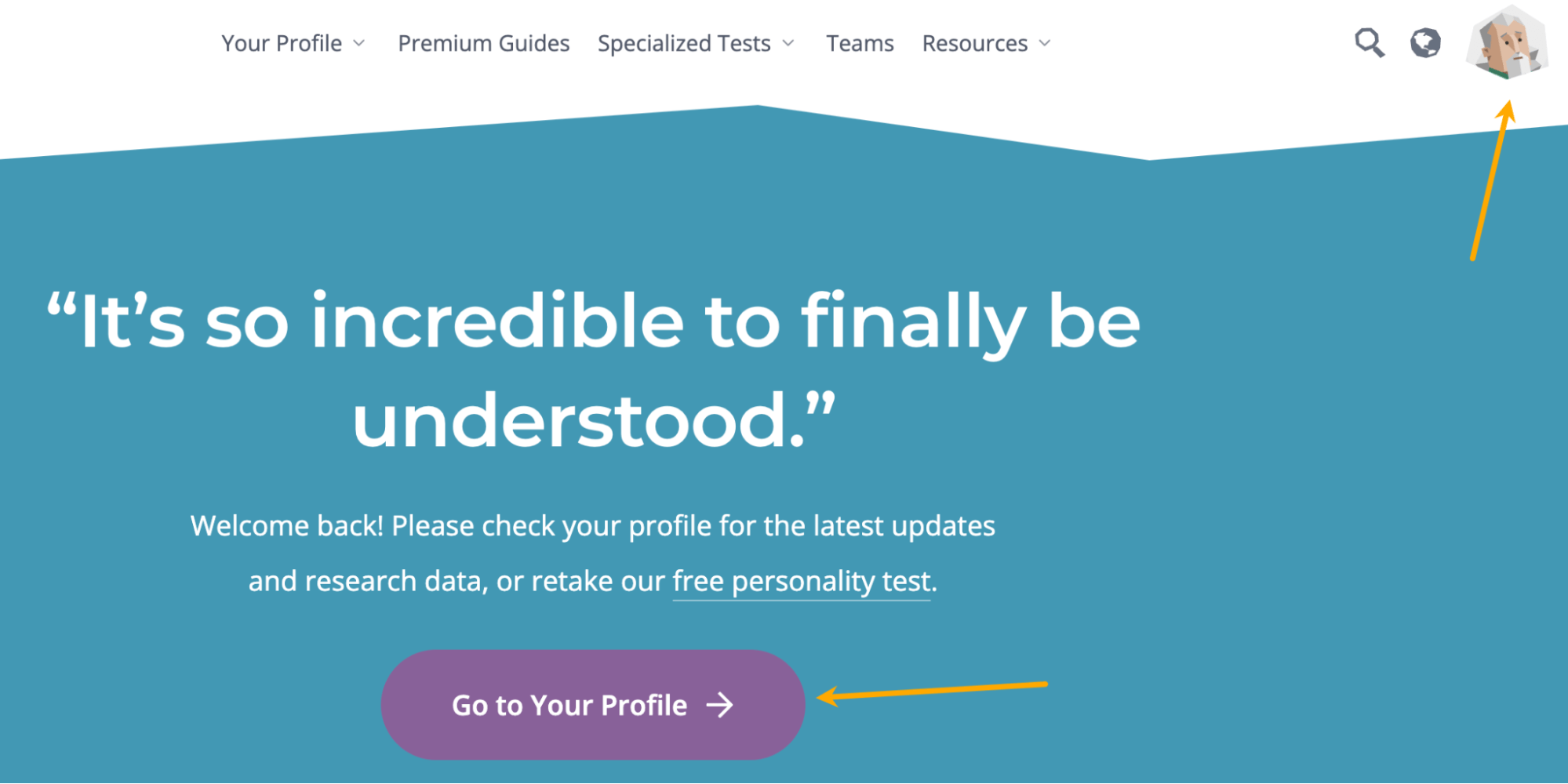
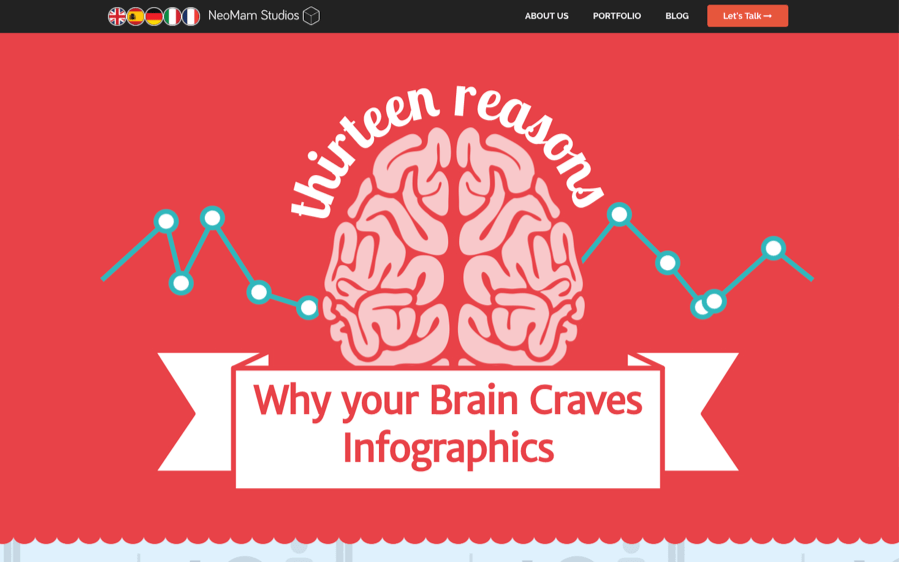
Estimated monthly organic traffic: 4
Backlinks: 4.1K from 329 domains
Launched in 2013, this is an infographic about why your brain craves infographics, created by an infographic design and marketing agency in the U.K.
It’s well designed and well researched. It’s also one of the few interactive pieces of content we’ve come across that actually resized correctly and worked on mobile (as of when this article was written).
Why it worked
The timing was almost certainly one of the biggest contributing factors here.
NeoMam published this piece of content in July 2013 which, according to Google Trends, was nearly the peak of a long-term trend of interest in infographics.
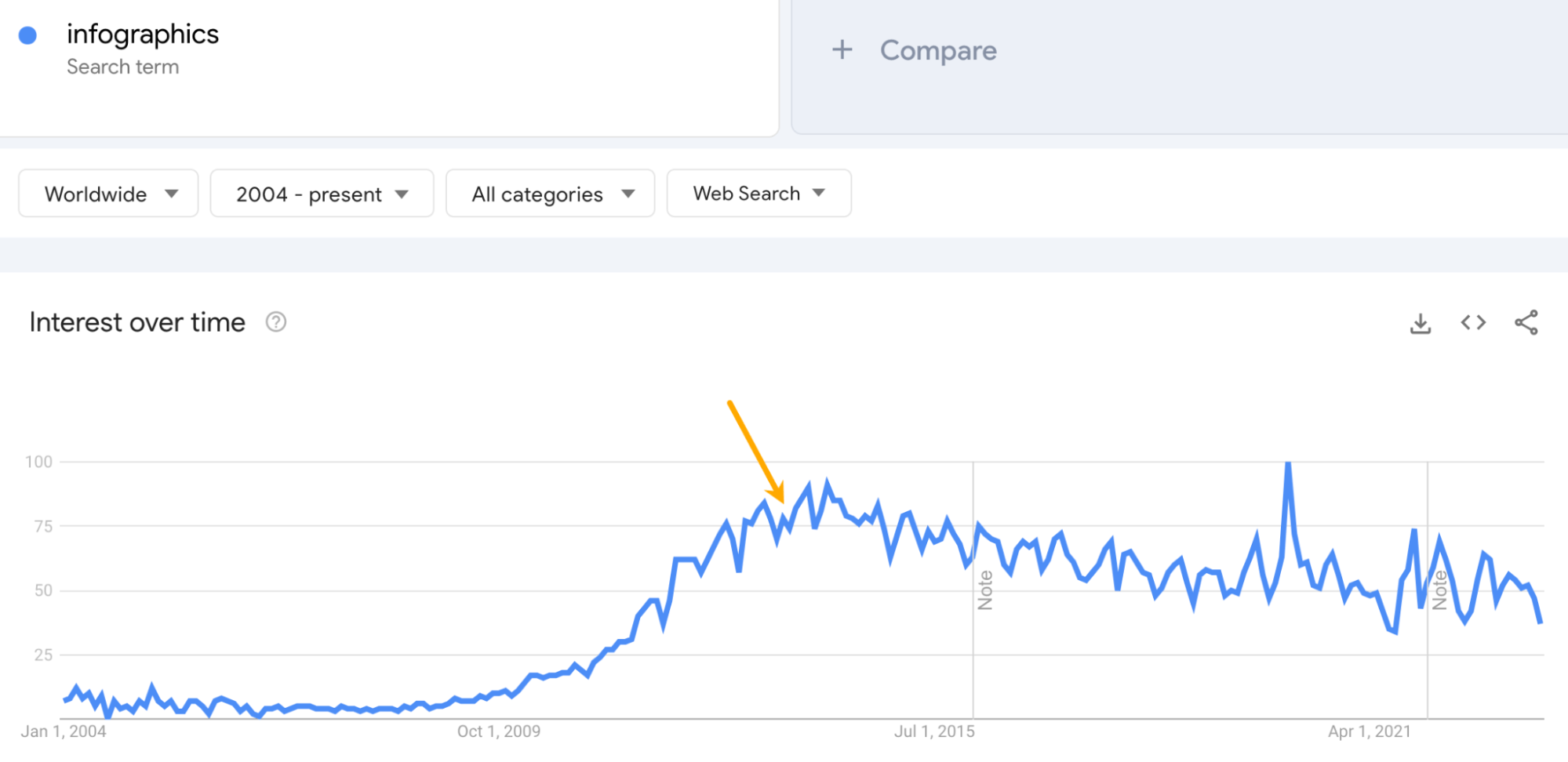
By publishing content about trending topics, you increase the pool of prospects who are likely to be interested in featuring the content. It’s akin to publishing something about the Barbie movie in 2023—if the content is good, journalists and bloggers will be falling over themselves to cover it.
And that’s exactly what happened in this case. NeoMam’s infographic got featured on a lot of huge sites, such as Huffington Post, Harvard Business Review, and Entrepreneur:

But what’s also notable is this work was featured in other lists like this one. So if someone looking for infographic inspiration comes across this example, they may hire the agency that created it.
Danny Ashton, the founder of NeoMam, also puts some of the success down to the quality and depth of research:
Back in 2013 you could get away with sources that didn’t quite make sense or just link to a blog. But one of the things I said to the team when we did this was to only talk about things that we could cite with a scientific journal. Going the extra mile when it comes to research quality was key for getting the trust from journalists looking to cover the story.

Estimated monthly organic traffic: 1.3M
Backlinks: 234K from 10.3K domains
CoinDesk is an online magazine devoted to cryptocurrencies, web3, and the underlying technology. This example is one of the web’s go-to sources for checking the latest price of Bitcoin and some related market data.
Why it worked
There are millions of searches for the live price of Bitcoin every month. With this page, CoinDesk ranks high for these searches and generates massive traffic it doesn’t need to pay for.
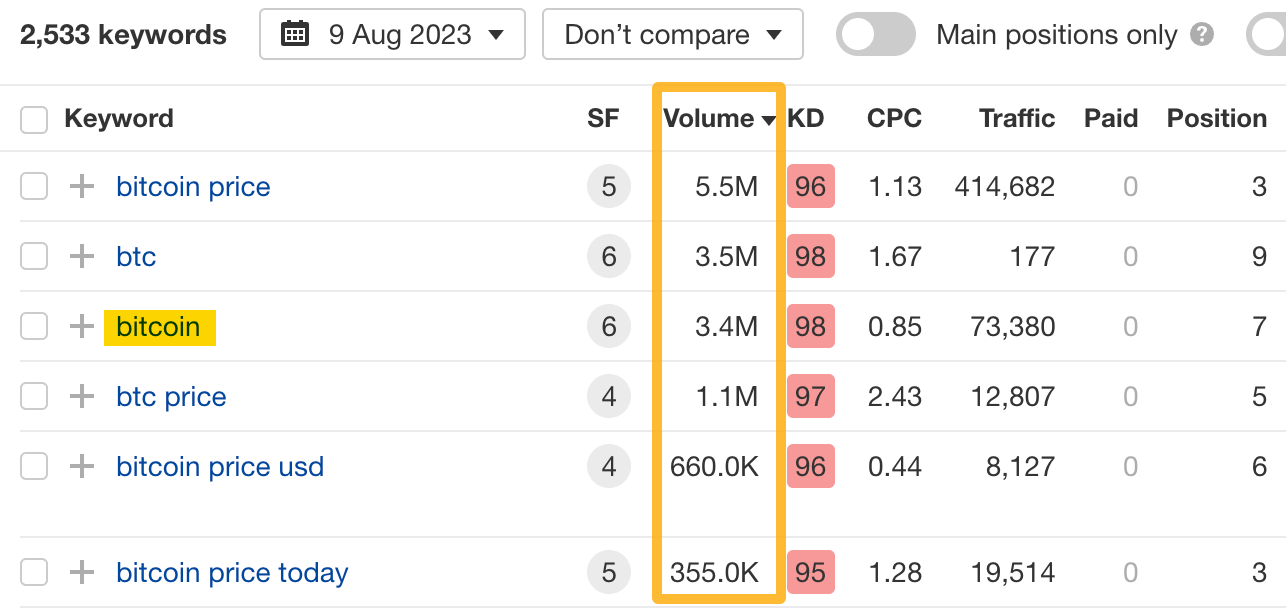
What’s in it for CoinDesk to go through all of that hassle to provide fresh market data? Especially when traders get their data from their trading apps? I can think of a few things:
- Advertising revenue from on-site ads, which get millions of views.
- Affiliate revenue—the “buy/sell” button you can see in the screenshot leads to third-party trading apps.
- Authority from all of the links pointing to that site. Which can, in turn, help it rank other content.
- Last but not least, increased readership. Its core content (news) is just a click away.
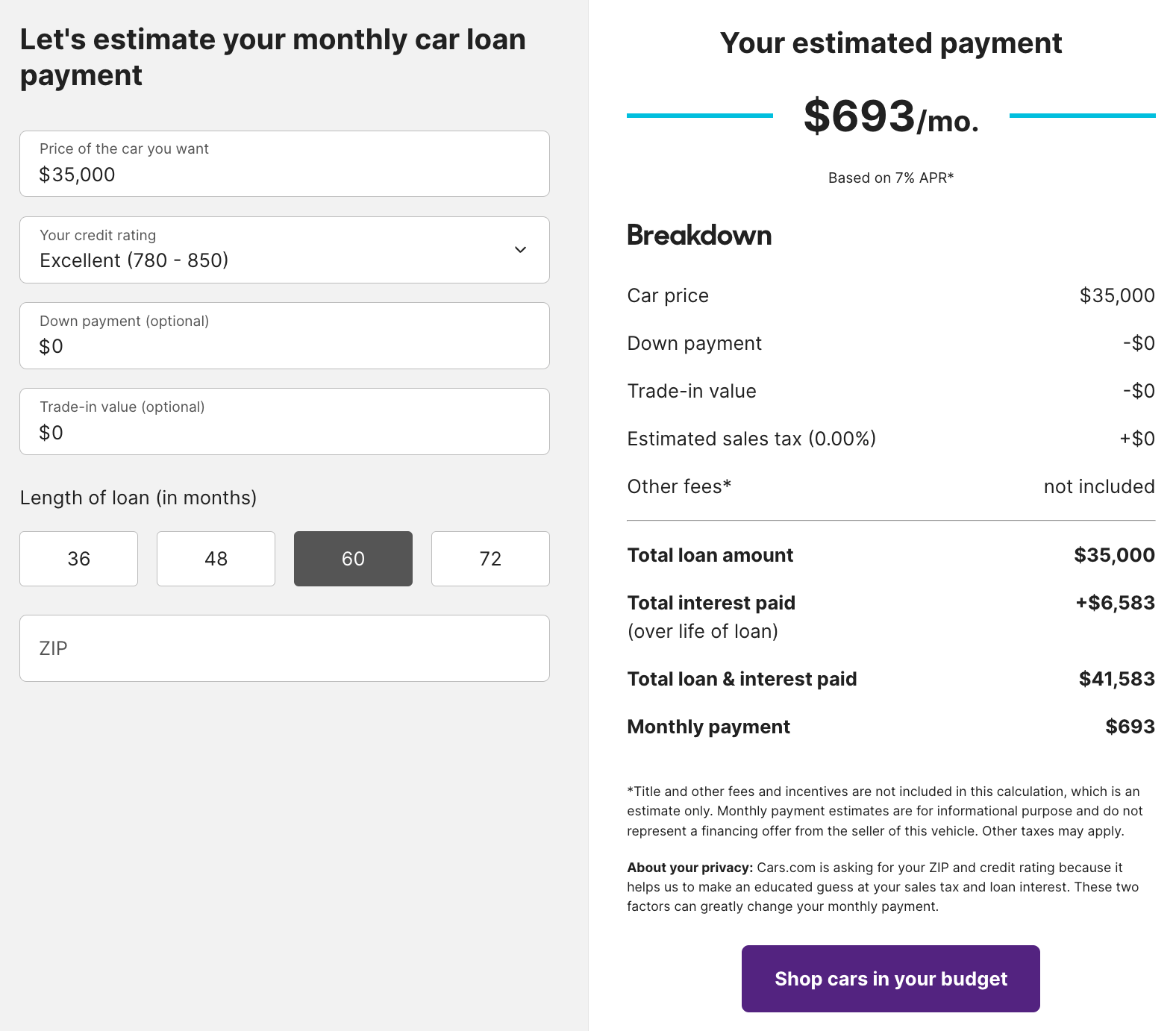
Estimated monthly organic traffic: 140K
Backlinks: 16.6K from 570 domains
Cars.com’s Auto Loan Calculator does exactly what it says on the tin. But as you may have guessed, cars.com is not in the calculator business—it’s an online car marketplace.
Once it calculates the monthly payment amount, there’s an auto-generated search box underneath that lets you “search for cars in your budget.” Of course, the list of cars comes from cars.com.
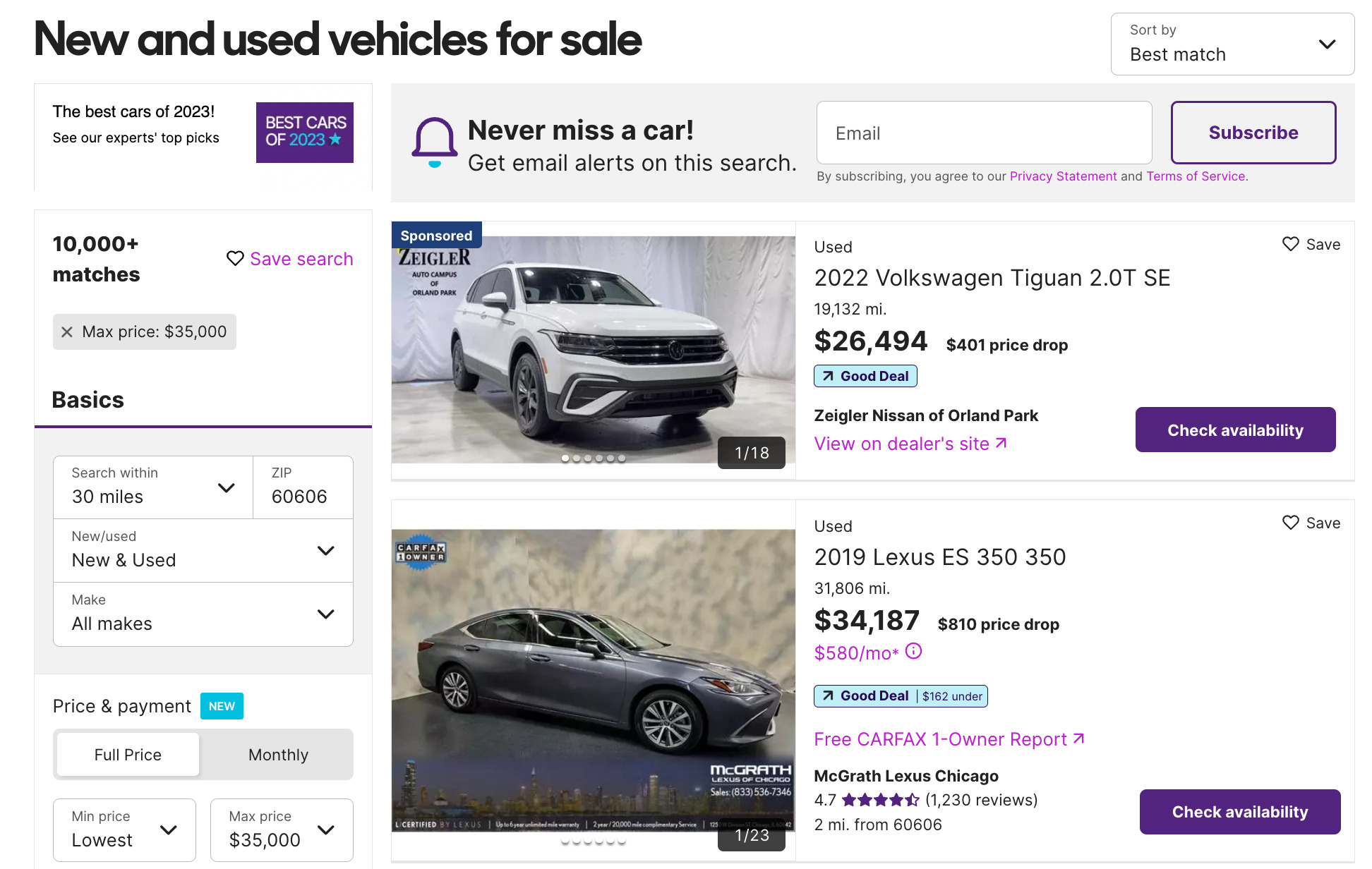
Why it worked
The phrase “car loan calculator” gets an estimated 475K monthly searches in the U.S.
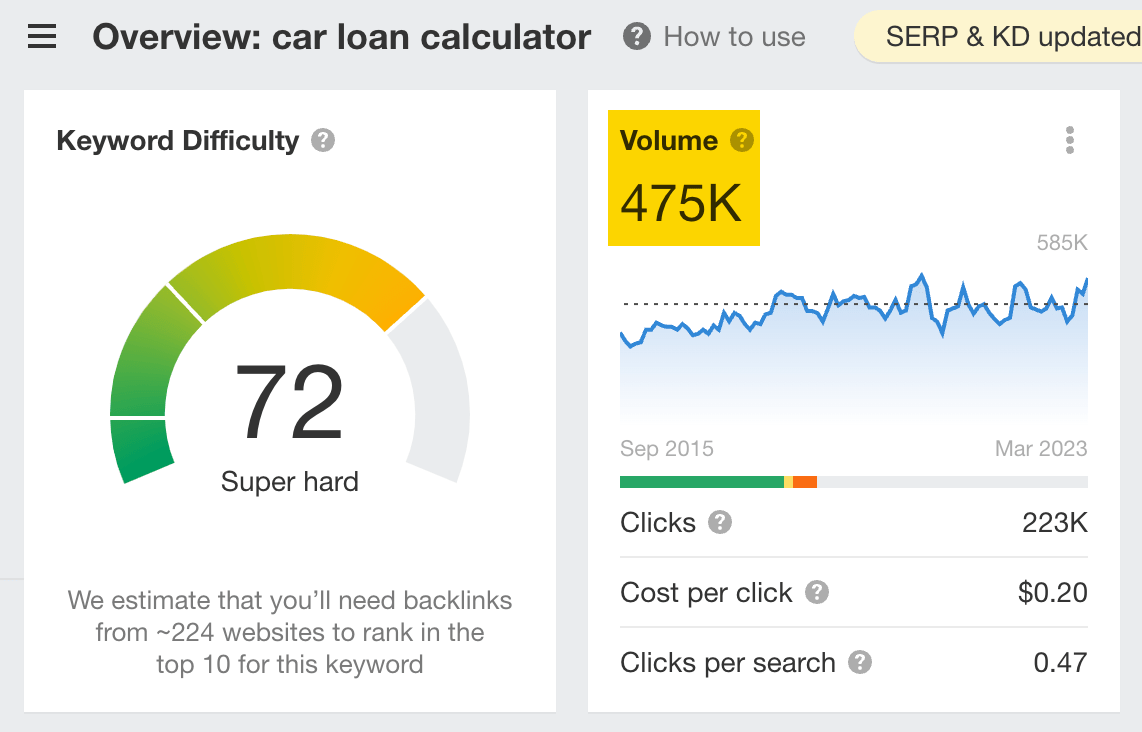
The calculator ranks in the top three in Google for that query. It also ranks in the top 100 for 8,970 other keywords, which also send traffic to the page resulting in an estimated 148,242 monthly visits.

That traffic then converts into leads when people search for cars on the website within that price range.

Estimated monthly organic traffic: 28
Backlinks: 1.1K from 545 domains
Superdrug, a health and beauty retailer in the U.K., asked female graphic designers from 18 different countries to retouch a photo of a woman to make her more attractive.
Here are just a few of the results:

A year later, it repeated the study with men:

Each resulting image and body type is vastly different from the rest—which is the entire point.
Superdrug aimed to show that there’s no such thing as the perfect body. It’s subjective, not definitive. What’s seen as the ideal body varies massively from country to country.
Why it worked
Superdrug launched this campaign in 2015 when, according to Google Trends, the body positivity movement was starting to gain traction.

That meant there were many journalists and bloggers eager to cover positive, thought-provoking content around this subject, which led to features in big news sites such as Huffington Post, The Telegraph, and Daily Mail.
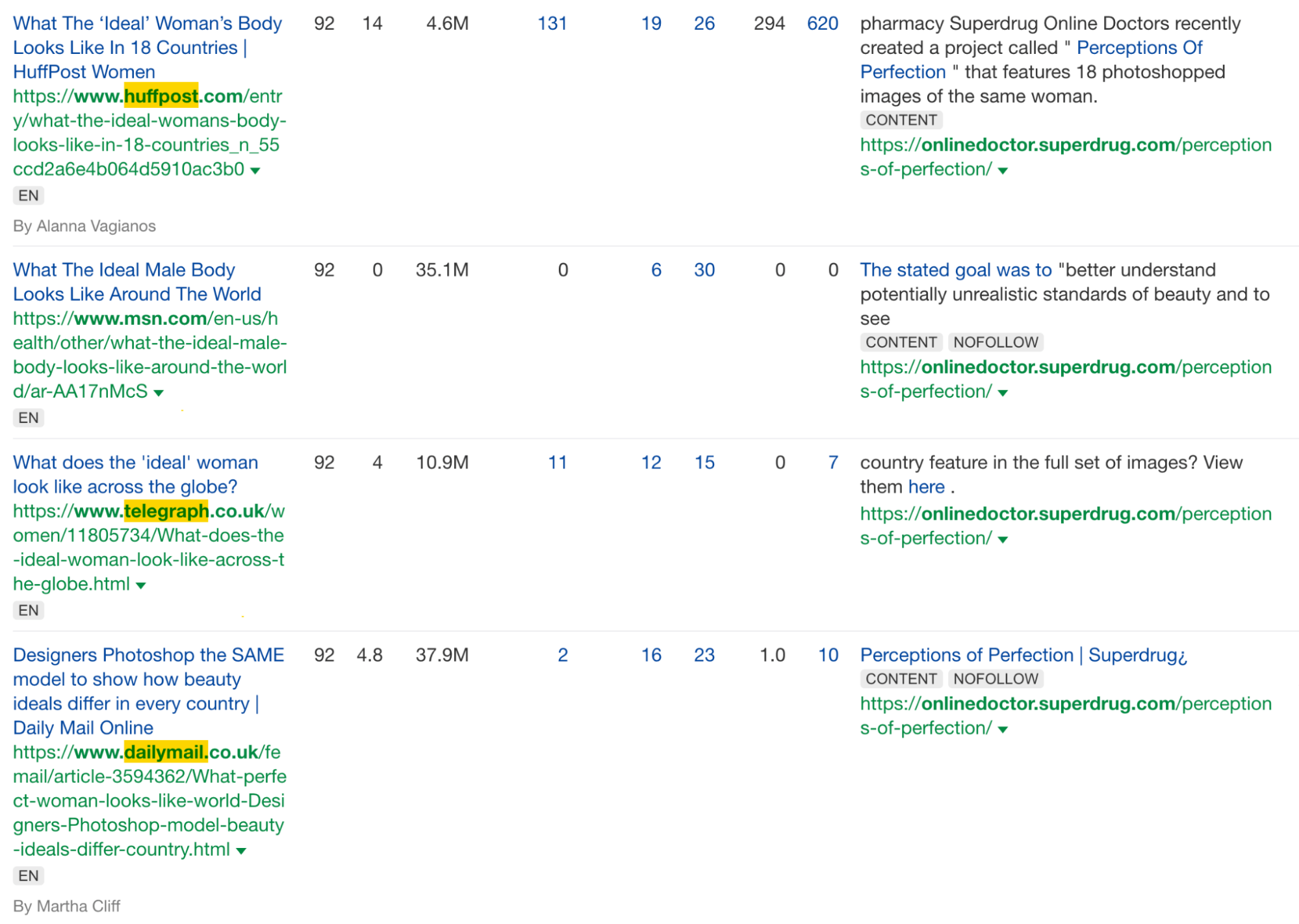
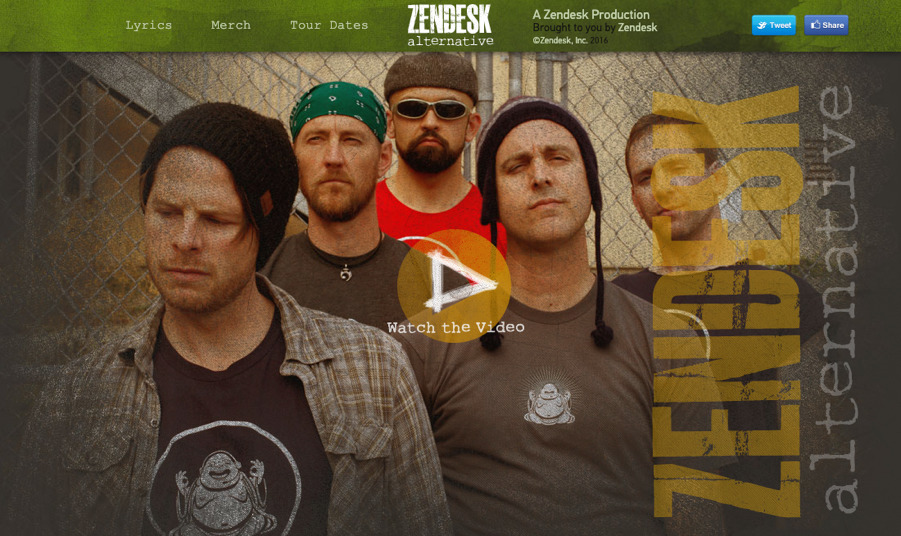
Estimated monthly organic traffic: 88
Backlinks: 475 from 329 domains
In 2013, Zendesk, a customer support solution, playfully created a fictional rock band called “Zendesk Alternative.” The band’s concept revolved around Zendesk stealing its name, leading to humorous and quirky situations.
Despite being entirely fake, Zendesk put in a lot of effort. It established the band on various platforms like Facebook, Bandcamp, or YouTube, giving it the appearance of a real act.
Why it worked
Not only is it funny and insanely well executed, but it actively targets customers considering other alternatives to Zendesk and attempts to win them over.
The page ranks in the top five search results most of the time on Google for “zendesk alternative,” a keyword that gets 800 searches per month in the U.S.
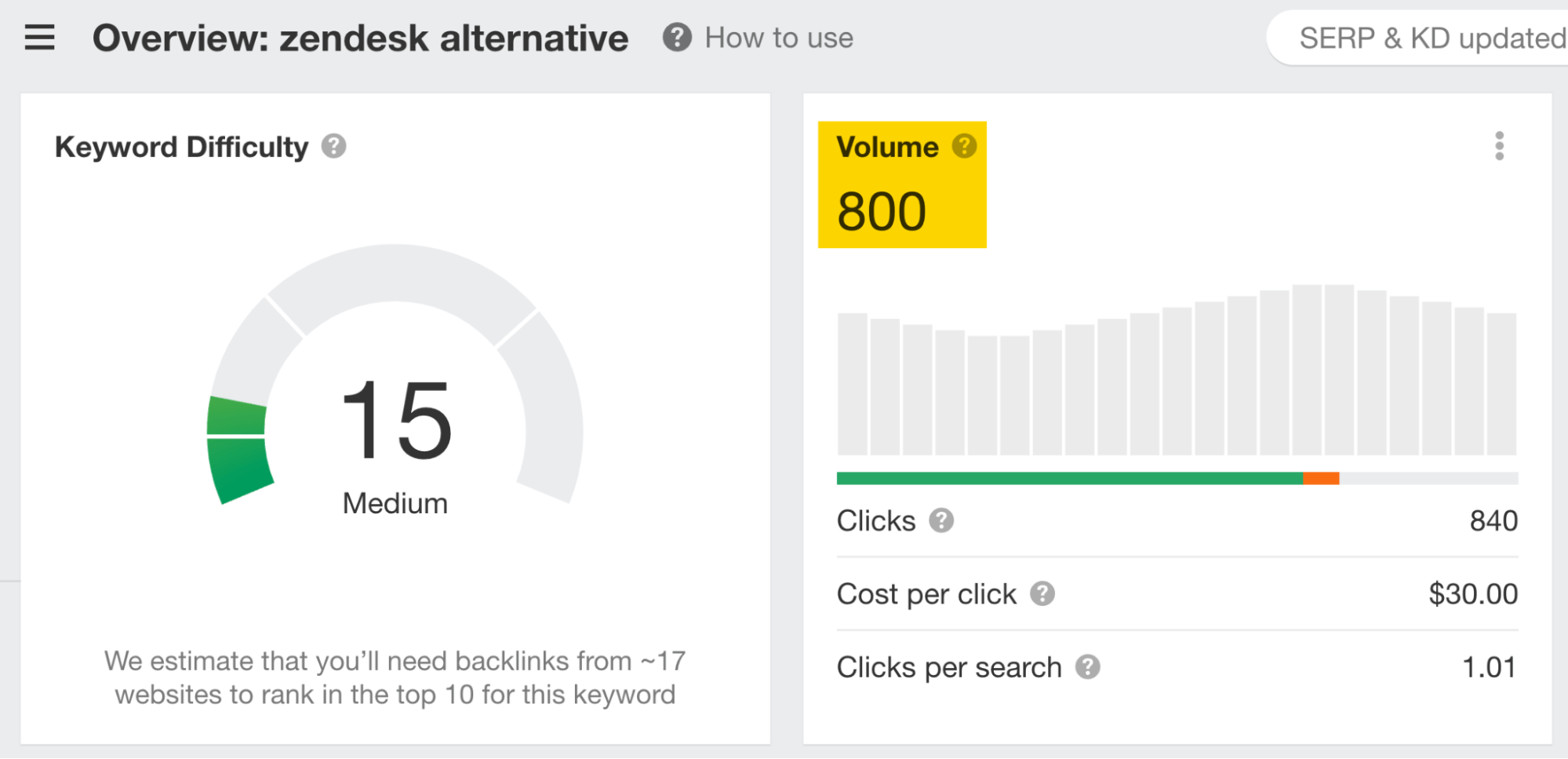
This is a keyword for which the bulk of traffic would ordinarily go to some other website.
Also, according to this archived article on radius.com, Zendesk closed five deals that originated from the Zendesk Alternative page within six months of the campaign going live.
Final thoughts
Every one of these examples relies on creating something of value (content) and promoting it to interested audiences (marketing).
They’re all relatively replicable and straightforward ideas at their core. Some of them may have required more resources, but others prove that you can create outstanding content even if you’re on a budget.
Do you know of any other cool content marketing examples? Let me know on Twitter or Mastodon.
SEO
How To Use ChatGPT For Keyword Research

Anyone not using ChatGPT for keyword research is missing a trick.
You can save time and understand an entire topic in seconds instead of hours.
In this article, I outline my most effective ChatGPT prompts for keyword research and teach you how I put them together so that you, too, can take, edit, and enhance them even further.
But before we jump into the prompts, I want to emphasize that you shouldn’t replace keyword research tools or disregard traditional keyword research methods.
ChatGPT can make mistakes. It can even create new keywords if you give it the right prompt. For example, I asked it to provide me with a unique keyword for the topic “SEO” that had never been searched before.
“Interstellar Internet SEO: Optimizing content for the theoretical concept of an interstellar internet, considering the challenges of space-time and interplanetary communication delays.”
Although I want to jump into my LinkedIn profile and update my title to “Interstellar Internet SEO Consultant,” unfortunately, no one has searched that (and they probably never will)!
You must not blindly rely on the data you get back from ChatGPT.
What you can rely on ChatGPT for is the topic ideation stage of keyword research and inspiration.
ChatGPT is a large language model trained with massive amounts of data to accurately predict what word will come next in a sentence. However, it does not know how to do keyword research yet.
Instead, think of ChatGPT as having an expert on any topic armed with the information if you ask it the right question.
In this guide, that is exactly what I aim to teach you how to do – the most essential prompts you need to know when performing topical keyword research.
Best ChatGPT Keyword Research Prompts
The following ChatGPT keyword research prompts can be used on any niche, even a topic to which you are brand new.
For this demonstration, let’s use the topic of “SEO” to demonstrate these prompts.
Generating Keyword Ideas Based On A Topic
What Are The {X} Most Popular Sub-topics Related To {Topic}?
The first prompt is to give you an idea of the niche.
As shown above, ChatGPT did a great job understanding and breaking down SEO into three pillars: on-page, off-page & technical.
The key to the following prompt is to take one of the topics ChatGPT has given and query the sub-topics.
What Are The {X} Most Popular Sub-topics Related To {Sub-topic}?
For this example, let’s query, “What are the most popular sub-topics related to keyword research?”
Having done keyword research for over 10 years, I would expect it to output information related to keyword research metrics, the types of keywords, and intent.
Let’s see.
 Screenshot from ChatGPT 4, April 2024
Screenshot from ChatGPT 4, April 2024Again, right on the money.
To get the keywords you want without having ChatGPT describe each answer, use the prompt “list without description.”
Here is an example of that.
List Without Description The Top {X} Most Popular Keywords For The Topic Of {X}
You can even branch these keywords out further into their long-tail.
Example prompt:
List Without Description The Top {X} Most Popular Long-tail Keywords For The Topic “{X}”
 Screenshot ChatGPT 4,April 2024
Screenshot ChatGPT 4,April 2024List Without Description The Top Semantically Related Keywords And Entities For The Topic {X}
You can even ask ChatGPT what any topic’s semantically related keywords and entities are!
 Screenshot ChatGPT 4, April 2024
Screenshot ChatGPT 4, April 2024Tip: The Onion Method Of Prompting ChatGPT
When you are happy with a series of prompts, add them all to one prompt. For example, so far in this article, we have asked ChatGPT the following:
- What are the four most popular sub-topics related to SEO?
- What are the four most popular sub-topics related to keyword research
- List without description the top five most popular keywords for “keyword intent”?
- List without description the top five most popular long-tail keywords for the topic “keyword intent types”?
- List without description the top semantically related keywords and entities for the topic “types of keyword intent in SEO.”
Combine all five into one prompt by telling ChatGPT to perform a series of steps. Example:
“Perform the following steps in a consecutive order Step 1, Step 2, Step 3, Step 4, and Step 5”
Example:
“Perform the following steps in a consecutive order Step 1, Step 2, Step 3, Step 4 and Step 5. Step 1 – Generate an answer for the 3 most popular sub-topics related to {Topic}?. Step 2 – Generate 3 of the most popular sub-topics related to each answer. Step 3 – Take those answers and list without description their top 3 most popular keywords. Step 4 – For the answers given of their most popular keywords, provide 3 long-tail keywords. Step 5 – for each long-tail keyword offered in the response, a list without descriptions 3 of their top semantically related keywords and entities.”
Generating Keyword Ideas Based On A Question
Taking the steps approach from above, we can get ChatGPT to help streamline getting keyword ideas based on a question. For example, let’s ask, “What is SEO?”
“Perform the following steps in a consecutive order Step 1, Step 2, Step 3, and Step 4. Step 1 Generate 10 questions about “{Question}”?. Step 2 – Generate 5 more questions about “{Question}” that do not repeat the above. Step 3 – Generate 5 more questions about “{Question}” that do not repeat the above. Step 4 – Based on the above Steps 1,2,3 suggest a final list of questions avoiding duplicates or semantically similar questions.”
 Screenshot ChatGPT 4, April 2024
Screenshot ChatGPT 4, April 2024Generating Keyword Ideas Using ChatGPT Based On The Alphabet Soup Method
One of my favorite methods, manually, without even using a keyword research tool, is to generate keyword research ideas from Google autocomplete, going from A to Z.
-
 Screenshot from Google autocomplete, April 2024
Screenshot from Google autocomplete, April 2024
You can also do this using ChatGPT.
Example prompt:
“give me popular keywords that includes the keyword “SEO”, and the next letter of the word starts with a”
 Screenshot from ChatGPT 4, April 2024
Screenshot from ChatGPT 4, April 2024Tip: Using the onion prompting method above, we can combine all this in one prompt.
“Give me five popular keywords that include “SEO” in the word, and the following letter starts with a. Once the answer has been done, move on to giving five more popular keywords that include “SEO” for each letter of the alphabet b to z.”
Generating Keyword Ideas Based On User Personas
When it comes to keyword research, understanding user personas is essential for understanding your target audience and keeping your keyword research focused and targeted. ChatGPT may help you get an initial understanding of customer personas.
Example prompt:
“For the topic of “{Topic}” list 10 keywords each for the different types of user personas”
 Screenshot from ChatGPT 4, April 2024
Screenshot from ChatGPT 4, April 2024You could even go a step further and ask for questions based on those topics that those specific user personas may be searching for:
 Screenshot ChatGPT 4, April 2024
Screenshot ChatGPT 4, April 2024As well as get the keywords to target based on those questions:
“For each question listed above for each persona, list the keywords, as well as the long-tail keywords to target, and put them in a table”
 Screenshot from ChatGPT 4, April 2024
Screenshot from ChatGPT 4, April 2024Generating Keyword Ideas Using ChatGPT Based On Searcher Intent And User Personas
Understanding the keywords your target persona may be searching is the first step to effective keyword research. The next step is to understand the search intent behind those keywords and which content format may work best.
For example, a business owner who is new to SEO or has just heard about it may be searching for “what is SEO.”
However, if they are further down the funnel and in the navigational stage, they may search for “top SEO firms.”
You can query ChatGPT to inspire you here based on any topic and your target user persona.
SEO Example:
“For the topic of “{Topic}” list 10 keywords each for the different types of searcher intent that a {Target Persona} would be searching for”
ChatGPT For Keyword Research Admin
Here is how you can best use ChatGPT for keyword research admin tasks.
Using ChatGPT As A Keyword Categorization Tool
One of the use cases for using ChatGPT is for keyword categorization.
In the past, I would have had to devise spreadsheet formulas to categorize keywords or even spend hours filtering and manually categorizing keywords.
ChatGPT can be a great companion for running a short version of this for you.
Let’s say you have done keyword research in a keyword research tool, have a list of keywords, and want to categorize them.
You could use the following prompt:
“Filter the below list of keywords into categories, target persona, searcher intent, search volume and add information to a six-column table: List of keywords – [LIST OF KEYWORDS], Keyword Search Volume [SEARCH VOLUMES] and Keyword Difficulties [KEYWORD DIFFICUTIES].”
-
 Screenshot from ChatGPT, April 2024
Screenshot from ChatGPT, April 2024
Tip: Add keyword metrics from the keyword research tools, as using the search volumes that a ChatGPT prompt may give you will be wildly inaccurate at best.
Using ChatGPT For Keyword Clustering
Another of ChatGPT’s use cases for keyword research is to help you cluster. Many keywords have the same intent, and by grouping related keywords, you may find that one piece of content can often target multiple keywords at once.
However, be careful not to rely only on LLM data for clustering. What ChatGPT may cluster as a similar keyword, the SERP or the user may not agree with. But it is a good starting point.
The big downside of using ChatGPT for keyword clustering is actually the amount of keyword data you can cluster based on the memory limits.
So, you may find a keyword clustering tool or script that is better for large keyword clustering tasks. But for small amounts of keywords, ChatGPT is actually quite good.
A great use small keyword clustering use case using ChatGPT is for grouping People Also Ask (PAA) questions.
Use the following prompt to group keywords based on their semantic relationships. For example:
“Organize the following keywords into groups based on their semantic relationships, and give a short name to each group: [LIST OF PAA], create a two-column table where each keyword sits on its own row.
-
 Screenshot from ChatGPT, April 2024
Screenshot from ChatGPT, April 2024
Using Chat GPT For Keyword Expansion By Patterns
One of my favorite methods of doing keyword research is pattern spotting.
Most seed keywords have a variable that can expand your target keywords.
Here are a few examples of patterns:
1. Question Patterns
(who, what, where, why, how, are, can, do, does, will)
“Generate [X] keywords for the topic “[Topic]” that contain any or all of the following “who, what, where, why, how, are, can, do, does, will”
 Screenshot ChatGPT 4, April 2024
Screenshot ChatGPT 4, April 20242. Comparison Patterns
Example:
“Generate 50 keywords for the topic “{Topic}” that contain any or all of the following “for, vs, alternative, best, top, review”
 Screenshot ChatGPT 4, April 2024
Screenshot ChatGPT 4, April 20243. Brand Patterns
Another one of my favorite modifiers is a keyword by brand.
We are probably all familiar with the most popular SEO brands; however, if you aren’t, you could ask your AI friend to do the heavy lifting.
Example prompt:
“For the top {Topic} brands what are the top “vs” keywords”
 Screenshot ChatGPT 4, April 2024
Screenshot ChatGPT 4, April 20244. Search Intent Patterns
One of the most common search intent patterns is “best.”
When someone is searching for a “best {topic}” keyword, they are generally searching for a comprehensive list or guide that highlights the top options, products, or services within that specific topic, along with their features, benefits, and potential drawbacks, to make an informed decision.
Example:
“For the topic of “[Topic]” what are the 20 top keywords that include “best”
 Screenshot ChatGPT 4, April 2024
Screenshot ChatGPT 4, April 2024Again, this guide to keyword research using ChatGPT has emphasized the ease of generating keyword research ideas by utilizing ChatGPT throughout the process.
Keyword Research Using ChatGPT Vs. Keyword Research Tools
Free Vs. Paid Keyword Research Tools
Like keyword research tools, ChatGPT has free and paid options.
However, one of the most significant drawbacks of using ChatGPT for keyword research alone is the absence of SEO metrics to help you make smarter decisions.
To improve accuracy, you could take the results it gives you and verify them with your classic keyword research tool – or vice versa, as shown above, uploading accurate data into the tool and then prompting.
However, you must consider how long it takes to type and fine-tune your prompt to get your desired data versus using the filters within popular keyword research tools.
For example, if we use a popular keyword research tool using filters, you could have all of the “best” queries with all of their SEO metrics:
-
 Screenshot from Ahrefs Keyword Explorer, March 2024
Screenshot from Ahrefs Keyword Explorer, March 2024
And unlike ChatGPT, generally, there is no token limit; you can extract several hundred, if not thousands, of keywords at a time.
As I have mentioned multiple times throughout this piece, you cannot blindly trust the data or SEO metrics it may attempt to provide you with.
The key is to validate the keyword research with a keyword research tool.
ChatGPT For International SEO Keyword Research
ChatGPT can be a terrific multilingual keyword research assistant.
For example, if you wanted to research keywords in a foreign language such as French. You could ask ChatGPT to translate your English keywords;
 Screenshot ChatGPT 4, Apil 2024
Screenshot ChatGPT 4, Apil 2024- The key is to take the data above and paste it into a popular keyword research tool to verify.
- As you can see below, many of the keyword translations for the English keywords do not have any search volume for direct translations in French.
 Screenshot from Ahrefs Keyword Explorer, April 2024
Screenshot from Ahrefs Keyword Explorer, April 2024But don’t worry, there is a workaround: If you have access to a competitor keyword research tool, you can see what webpage is ranking for that query – and then identify the top keyword for that page based on the ChatGPT translated keywords that do have search volume.
-
-
 Screenshot from Ahrefs Keyword Explorer, April 2024
Screenshot from Ahrefs Keyword Explorer, April 2024
Or, if you don’t have access to a paid keyword research tool, you could always take the top-performing result, extract the page copy, and then ask ChatGPT what the primary keyword for the page is.
Key Takeaway
-
ChatGPT can be an expert on any topic and an invaluable keyword research tool. However, it is another tool to add to your toolbox when doing keyword research; it does not replace traditional keyword research tools.
As shown throughout this tutorial, from making up keywords at the beginning to inaccuracies around data and translations, ChatGPT can make mistakes when used for keyword research.
You cannot blindly trust the data you get back from ChatGPT.
However, it can offer a shortcut to understanding any topic for which you need to do keyword research and, as a result, save you countless hours.
But the key is how you prompt.
The prompts I shared with you above will help you understand a topic in minutes instead of hours and allow you to better seed keywords using keyword research tools.
It can even replace mundane keyword clustering tasks that you used to do with formulas in spreadsheets or generate ideas based on keywords you give it.
Paired with traditional keyword research tools, ChatGPT for keyword research can be a powerful tool in your arsenal.
More resources:
Featured Image: Tatiana Shepeleva/Shutterstock
SEO
Google Hints At Improving Site Rankings In Next Update

Google’s John Mueller says the Search team is “explicitly evaluating” how to reward sites that produce helpful, high-quality content when the next core update rolls out.
The comments came in response to a discussion on X about the impact of March’s core update and September’s helpful content update.
In a series of tweets, Mueller acknowledged the concerns, stating:
“I imagine for most sites strongly affected, the effects will be site-wide for the time being, and it will take until the next update to see similar strong effects (assuming the new state of the site is significantly better than before).”
He added:
“I can’t make any promises, but the team working on this is explicitly evaluating how sites can / will improve in Search for the next update. It would be great to show more users the content that folks have worked hard on, and where sites have taken helpfulness to heart.”
What Does This Mean For SEO Professionals & Site Owners?
Mueller’s comments confirm Google is aware of critiques about the March core update and is refining its ability to identify high-quality sites and reward them appropriately in the next core update.
For websites, clearly demonstrating an authentic commitment to producing helpful and high-quality content remains the best strategy for improving search performance under Google’s evolving systems.
The Aftermath Of Google’s Core Updates
Google’s algorithm updates, including the September “Helpful Content Update” and the March 2024 update, have far-reaching impacts on rankings across industries.
While some sites experienced surges in traffic, others faced substantial declines, with some reporting visibility losses of up to 90%.
As website owners implement changes to align with Google’s guidelines, many question whether their efforts will be rewarded.
There’s genuine concern about the potential for long-term or permanent demotions for affected sites.
Recovery Pathway Outlined, But Challenges Remain
In a previous statement, Mueller acknowledged the complexity of the recovery process, stating that:
“some things take much longer to be reassessed (sometimes months, at the moment), and some bigger effects require another update cycle.”
Mueller clarified that not all changes would require a new update cycle but cautioned that “stronger effects will require another update.”
While affirming that permanent changes are “not very useful in a dynamic world,” Mueller adds that “recovery” implies a return to previous levels, which may be unrealistic given evolving user expectations.
“It’s never ‘just-as-before’,” Mueller stated.
Improved Rankings On The Horizon?
Despite the challenges, Mueller has offered glimmers of hope for impacted sites, stating:
“Yes, sites can grow again after being affected by the ‘HCU’ (well, core update now). This isn’t permanent. It can take a lot of work, time, and perhaps update cycles, and/but a different – updated – site will be different in search too.”
He says the process may require “deep analysis to understand how to make a website relevant in a modern world, and significant work to implement those changes — assuming that it’s something that aligns with what the website even wants.”
Looking Ahead
Google’s search team is actively working on improving site rankings and addressing concerns with the next core update.
However, recovery requires patience, thorough analysis, and persistent effort.
The best way to spend your time until the next update is to remain consistent and produce the most exceptional content in your niche.
FAQ
How long does it generally take for a website to recover from the impact of a core update?
Recovery timelines can vary and depend on the extent and type of updates made to align with Google’s guidelines.
Google’s John Mueller noted that some changes might be reassessed quickly, while more substantial effects could take months and require additional update cycles.
Google acknowledges the complexity of the recovery process, indicating that significant improvements aligned with Google’s quality signals might be necessary for a more pronounced recovery.
What impact did the March and September updates have on websites, and what steps should site owners take?
The March and September updates had widespread effects on website rankings, with some sites experiencing traffic surges while others faced up to 90% visibility losses.
Publishing genuinely useful, high-quality content is key for website owners who want to bounce back from a ranking drop or maintain strong rankings. Stick to Google’s recommendations and adapt as they keep updating their systems.
To minimize future disruptions from algorithm changes, it’s a good idea to review your whole site thoroughly and build a content plan centered on what your users want and need.
Is it possible for sites affected by core updates to regain their previous ranking positions?
Sites can recover from the impact of core updates, but it requires significant effort and time.
Mueller suggested that recovery might happen over multiple update cycles and involves a deep analysis to align the site with current user expectations and modern search criteria.
While a return to previous levels isn’t guaranteed, sites can improve and grow by continually enhancing the quality and relevance of their content.
Featured Image: eamesBot/Shutterstock
SEO
Google Reveals Two New Web Crawlers

Google revealed details of two new crawlers that are optimized for scraping image and video content for “research and development” purposes. Although the documentation doesn’t explicitly say so, it’s presumed that there is no impact in ranking should publishers decide to block the new crawlers.
It should be noted that the data scraped by these crawlers are not explicitly for AI training data, that’s what the Google-Extended crawler is for.
GoogleOther Crawlers
The two new crawlers are versions of Google’s GoogleOther crawler that was launched in April 2023. The original GoogleOther crawler was also designated for use by Google product teams for research and development in what is described as one-off crawls, the description of which offers clues about what the new GoogleOther variants will be used for.
The purpose of the original GoogleOther crawler is officially described as:
“GoogleOther is the generic crawler that may be used by various product teams for fetching publicly accessible content from sites. For example, it may be used for one-off crawls for internal research and development.”
Two GoogleOther Variants
There are two new GoogleOther crawlers:
- GoogleOther-Image
- GoogleOther-Video
The new variants are for crawling binary data, which is data that’s not text. HTML data is generally referred to as text files, ASCII or Unicode files. If it can be viewed in a text file then it’s a text file/ASCII/Unicode file. Binary files are files that can’t be open in a text viewer app, files like image, audio, and video.
The new GoogleOther variants are for image and video content. Google lists user agent tokens for both of the new crawlers which can be used in a robots.txt for blocking the new crawlers.
1. GoogleOther-Image
User agent tokens:
- GoogleOther-Image
- GoogleOther
Full user agent string:
GoogleOther-Image/1.0
2. GoogleOther-Video
User agent tokens:
- GoogleOther-Video
- GoogleOther
Full user agent string:
GoogleOther-Video/1.0
Newly Updated GoogleOther User Agent Strings
Google also updated the GoogleOther user agent strings for the regular GoogleOther crawler. For blocking purposes you can continue using the same user agent token as before (GoogleOther). The new Users Agent Strings are just the data sent to servers to identify the full description of the crawlers, in particular the technology used. In this case the technology used is Chrome, with the model number periodically updated to reflect which version is used (W.X.Y.Z is a Chrome version number placeholder in the example listed below)
The full list of GoogleOther user agent strings:
- Mozilla/5.0 (Linux; Android 6.0.1; Nexus 5X Build/MMB29P) AppleWebKit/537.36 (KHTML, like Gecko) Chrome/W.X.Y.Z Mobile Safari/537.36 (compatible; GoogleOther)
- Mozilla/5.0 AppleWebKit/537.36 (KHTML, like Gecko; compatible; GoogleOther) Chrome/W.X.Y.Z Safari/537.36
GoogleOther Family Of Bots
These new bots may from time to time show up in your server logs and this information will help in identifying them as genuine Google crawlers and will help publishers who may want to opt out of having their images and videos scraped for research and development purposes.
Read the updated Google crawler documentation
Featured Image by Shutterstock/ColorMaker
-

 MARKETING6 days ago
MARKETING6 days ago18 Events and Conferences for Black Entrepreneurs in 2024
-

 MARKETING7 days ago
MARKETING7 days agoIAB Podcast Upfront highlights rebounding audiences and increased innovation
-

 PPC6 days ago
PPC6 days agoGoogle Ads Benchmarks 2024: New Trends & Insights for Key Industries
-

 SEO6 days ago
SEO6 days agoWhy Google Can’t Tell You About Every Ranking Drop
-

 SEO7 days ago
SEO7 days agoHow To Use ChatGPT For Keyword Research
-

 PPC7 days ago
PPC7 days agoThe Ultimate Guide to Click Fraud
-

 PPC6 days ago
PPC6 days ago86 Summer-Ready June Content Ideas
-

 SEO7 days ago
SEO7 days ago56 Google Search Statistics to Bookmark for 2024








